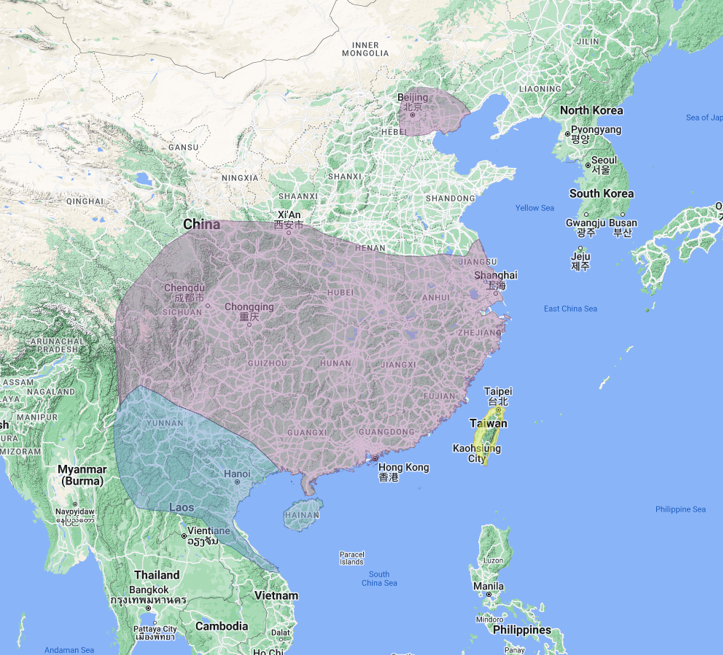Birdfinding.info ⇒ A common garden bird in central and eastern China—including the metropolitan areas of Beijing, Shanghai, Hong Kong, among other cities. Scarce elsewhere. Occasional year-round in South Korea, especially city parks in Seoul such as Olympic Park. Regular in winter on Taiwan, where it appears to be reported most often from city parks in Taipei. In Vietnam winterers have been found regularly in Hanoi and Da Nang. In Thailand the most consistent site has been Doi Pha Hom Pok National Park.
Chinese Blackbird
Turdus mandarinus
East Asia, in woodlands and gardens, including agricultural and settled areas.
Breeding. Nests in various kinds of temperate and subtropical woodlands—including the full spectrum of evergreen, mixed, and deciduous forests, riparian corridors, urban parks and gardens, and other semiopen landscapes with scattered trees—of central and eastern China north to Hebei, west to the mountains of southern Gansu, Sichuan, and northern Yunnan, and south to Guangxi.
A small outpost population appears tenuously established around Seoul, South Korea, where it has been detected breeding in 2019, 2021, and 2022.
Movements. In winter, its distribution generally shifts southward, but it does not completely withdraw from the northern portions of its range.
A substantial fraction of the population moves south into the subtropical and tropical zones of southern China and beyond—regularly south to central Vietnam and Hainan.
Smaller numbers winter south into the interior of Southeast Asia (to Laos and northern Thailand) and east to Taiwan and the Korean Peninsula.
Casual or accidental south to the Gulf of Thailand and east to the Ryukyu Islands and elsewhere in Japan. There is a single record from India’s Andaman Islands: a vagrant photographed on Narcondam Island on November 12, 2020.
Identification
A typical Turdus thrush, the East Asian counterpart to the more familiar Common Blackbird of the Western Palearctic and central Asia, with which it was traditionally regarded as conspecific. Often feeds on open ground, including lawns.
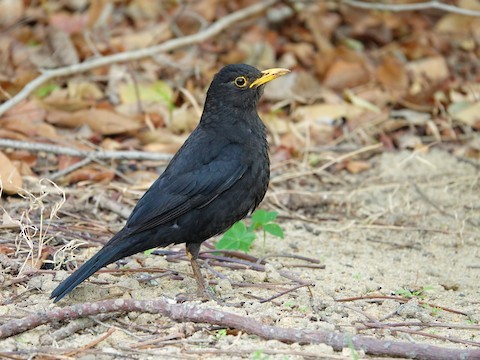
Chinese Blackbird, male. (Kinmen Botanical Garden, Kinmen County, Taiwan; February 28, 2021.) © Frederic Liu
Males of the two widespread Eurasian blackbirds are essentially identical: entirely coal-black plumage and a yellow bill and orbital skin.
The sexes are similar, but not identical. Females often closely resemble males, but are usually browner and often show a paler, vaguely streaked throat. The female’s bill is yellow like the male’s, but tends to be duller.
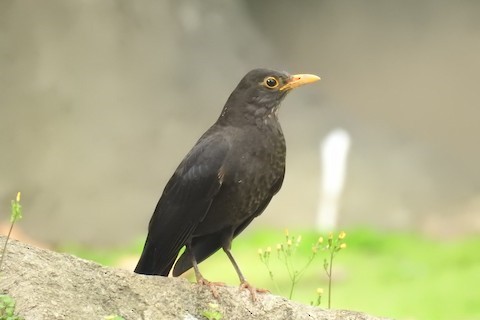
Chinese Blackbird, female showing partly streaked throat. (Taipei, Taiwan; March 4, 2018.) © Arlango Lee
At opposite ends of the spectrum, some males have significantly blacker plumage and more vivid bill color than females, and some females have much browner plumage and duller bill color than males, but birds near the middle of the spectrum cannot be visually distinguished as male or female.
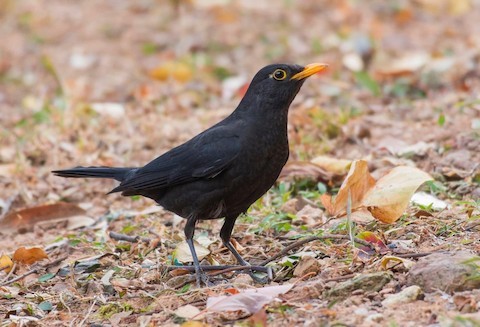
Chinese Blackbird, male with relatively vivid orangish bill. (Yuen Long Park, Hong Kong; December 20, 2019.) © Koel Ko
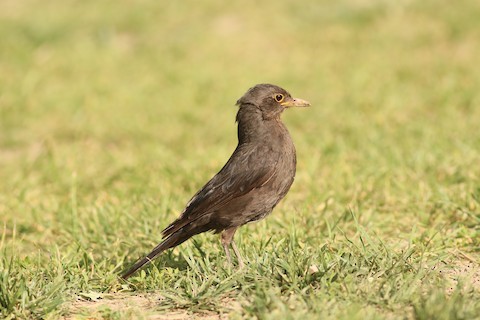
Chinese Blackbird, female at the pale-brown end of the spectrum. (Temple of Heaven, Beijing, China; May 11, 2021.) © Ian Hubbard
Unlike the Common Blackbird, many Chinese Blackbirds of both sexes develop a bare post-ocular streak.

Chinese Blackbird, male with bare post-ocular streak. (Con Ma, Da Nang, Vietnam; December 26, 2020.) © Ngoc Sam Thuong Dang

Chinese Blackbird, female with bare post-ocular streak. (Shanghai, China; July 2, 2022.) © Jonathan Hu
Immatures are mostly blackish and, unlike adults, have dark bills.

Chinese Blackbird, immature showing dark bill and streaked throat—thus likely a female. (Mailiao, Yunlin County, Taiwan; November 10, 2019.) © 張 俊章

Chinese Blackbird, juvenile. (Olympic Park, Seoul, South Korea; July 10, 2022.) © Christopher Adler
Juveniles are blackish or blackish brown overall, usually somewhat paler and browner than adults. The underparts are paler with whitish spots, and the throat is often mostly white.
Voice. Variable and reminiscent of, but more limited than, the famously virtuoso vocalist Common Blackbird. Simple song consists of series of flute-like whistles, typically the same sweet note repeated about 5-to-10 times in a row: Sometimes switches between whistles on different notes: Also frequently engages in lively babbling sessions with bouts of whistles, chuckles, and chatter in rapid succession:Typical calls include high, thin, metallic squeaks:When alarmed, often clucks and squeaks excitedly:
Notes
Polytypic species consisting of two recognized subspecies. Formerly considered conspecific with the Common Blackbird (merula), Tibetan Blackbird (maximus), and Indian Blackbird (simillimus).
More Images of the Chinese Blackbird

Chinese Blackbird, male with deep-black plumage and relatively vivid orangish bill. (Shenzhen, Guangdong, China; May 2021.) © sophie-g

Chinese Blackbird, female with typically blackish-brown coloration. (Eocheong Island, Jeonrabugdo, South Korea; April 20, 2006.) © Robert Newlin
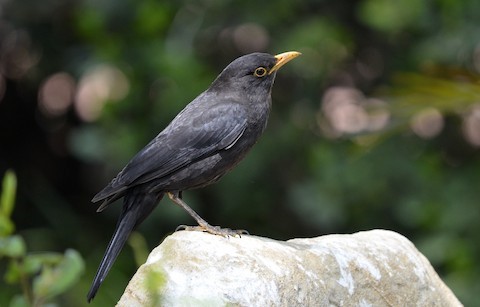
Chinese Blackbird, male. (Zhengzhou, Henan, China; April 7, 2022.) © Yiqi Yang
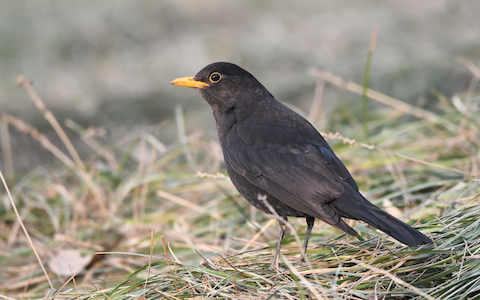
Chinese Blackbird, male. (Chaoyang Park, Beijing, China; March 10, 2019.) © Oriental Stork

Chinese Blackbird, partially leucistic male. (Sun Yat-sen University, Guangzhou, Guangdong, China; April 5, 2019.) © Xiwen Chen
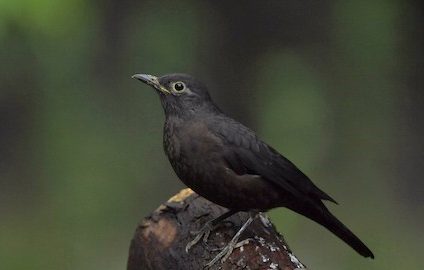
Chinese Blackbird, immature with bare post-ocular streak. (Guangdong, China; September 26, 2020.) © Xiwen Chen
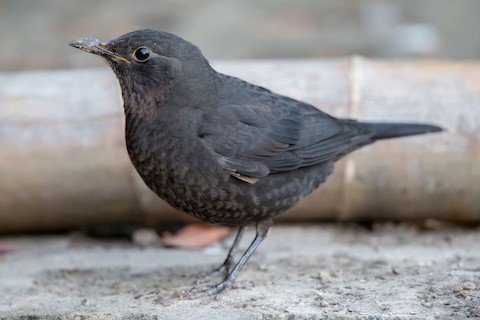
Chinese Blackbird, immature with bare post-ocular streak. (Nanhui Dongtan, Shanghai, China; November 9, 2020.) © Kai Pflug

Chinese Blackbird, juvenile. (Yuanmingyuan Relic Park, Beijing, China; June 30, 2022.) © Zhuofei Lu
References
BirdLife International. 2018. Turdus mandarinus. The IUCN Red List of Threatened Species 2018: e.T103888237A132201482. https://dx.doi.org/10.2305/IUCN.UK.2018-2.RLTS.T103888237A132201482.en. (Accessed September 30, 2022.)
Brazil, M. 2009. Birds of East Asia. Princeton University Press.
eBird. 2022. eBird: An online database of bird distribution and abundance. Cornell Lab of Ornithology, Ithaca, N.Y. http://www.ebird.org. (Accessed September 30, 2022.)
Robson, C. 2002. Birds of Thailand. Princeton University Press.
Xeno-Canto. 2022. Chinese Blackbird – Turdus mandarinus. https://xeno-canto.org/species/Turdus-mandarinus. (Accessed September 30, 2022.)

